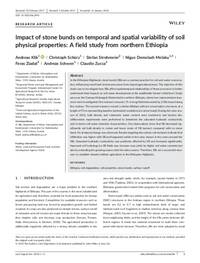Impact of stone bunds on temporal and spatial variability of soil physical properties: a field study from northern Ethiopia

Authors:
In the Ethiopian Highlands, stone bunds are a common practice for soil and water conservation,
influencing runoff and erosion processes from sloped agricultural areas. The objective of this study was
to investigate how stone bunds affect spatio-temporal relationships of these processes to better
understand their impacts on soil water development at the smallholder farmer's field level. Study area
was the Gumara-Maksegnit Watershed in Northern Ethiopia, where two representative transects were
investigated: One transect crossed a 71 m long field intersected by two stone bunds (SB) traced along
the contour. The second transect crossed a similar hillslope without conservation structures at a length
of 55 m representing baseline (untreated) conditions (NSB). During the rainy season 2012, bulk density,
volumetric water content were monitored as well as tension disc infiltrometer experiments were
performed to determine the saturated hydraulic conductivity and to derive soil water retention
characteristics. Our observations show that SB decreased significantly soil bulk density in center and
lower zones of SB transect compared to NSB. No temporal change was observed. Results targeting the
surface soil moisture indicate that infiltration was higher with SB and happened earlier in the rainy
season in the zones around the SB. Saturated hydraulic conductivity was positively affected by SB and
increased significantly. Improved soil hydrology by SB fields may increase crop yields by higher soil water
contents but also by extending the growing season after the rainy season. Therefore, stone bunds are a
successful measure to establish climate-resilient agriculture in the Ethiopian highlands.
